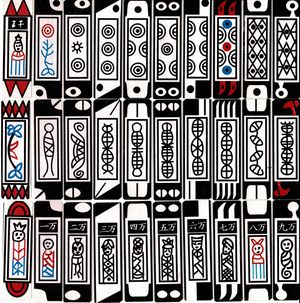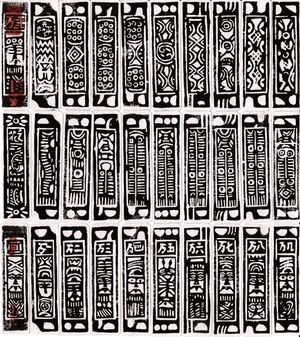Last updated: .
Gough mentions having a deck of these, Gough (1787, p. 171):
I have authority in my own poſſesſſion for ſaying that the Chineſe uſe cards marked and ſorted in ſuits like thoſe of Europe, not only from a Chineſe painting where their ladies are repreſented playing at a game with ſomething much thicker in ſubſtance than cards,A domino tile game of some kind. Note that Mahjong had not yet been invented. but ſhaped and numbered like them. One of theſe has on it ſix ace, anodhter ſix as on the cards called Domino cards among us. But I have alſo a pack of Chineſe cards made of the ſame materials as European, and charged with various devices to no great or regular nubmers. The whole pack conſiſts only of thirty cards, and of theſe nine have human faces, one whole length figures, and one two faces one under the other.This is the Zhu Tong card. The whole length figure has on it a red ſtamp with characters, and there are two ſuch ſtamps on one of the faces.
A deck in the Pitts River museum: https://www.prm.ox.ac.uk/collections-online#/item/prm-object-257079
https://www.prm.ox.ac.uk/collections-online#/item/prm-object-150407
Many decks in the Penn Museum.

Handmade cards from the town of Sanhe (三河鎮).
© George Pollard 🅭🅯🄏🄎

Handmade cards from the city of Suzhou (宿州).
© George Pollard 🅭🅯🄏🄎

Héhuā (荷花) brand cards. This deck only has one type of honour card.
© George Pollard 🅭🅯🄏🄎
#Nantong Pattern

© George Pollard 🅭🅯🄏🄎
#References
Gough, Richard (). ‘Some observations on the Invention of Cards and their Introduction into England’. Archaeologia: or, Miscellaneous Tracts relating to Antiquity vol. 8: pages 152–164. The Society of Antiquaries of London: London.